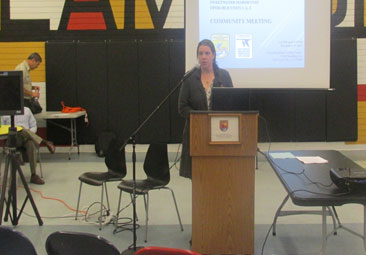
The U.S. Fish and Wildlife Service hosted two public meetings Tuesday at National City’s Casa de Salud, seeking public comments about proposed cleanup alternatives for two separate areas of the Sweetwater Marsh and a third area once the U.S. Fish and Wildlife completes their analysis.
U.S. Fish and Wildlife will be accepting written comments on the Engineering Evaluation and Cost Analysis until Dec. 15.
Members of the public can view the Engineering Evaluation and Cost Analysis online at www.fws.refuge_san_diego_bay/what_we_do/resource_management/Sweetwater _Marsh_Restoration.
The plan is to remove and replace containments with new, clean dirt and install native plants like salt marsh plants.
Laura Cox, public information officer with the U.S. Fish and Wildlife, said there is a good possibility that the public comment period might be extended.
“If they want to submit comments on how we think we should be doing this cleanup process or if they want to ask questions or provide feedback, we want to hear them,” Cox said.
Cox said so far the agency hasn’t received many comments on the project because most people do not know about it.
“The reason why there isn’t a huge public involvement in this or interest is because there areas are typically closed to the public because of the wildlife,” she said.
The cleaning has been in the works for more than 10 years, Cox said there isn’t a timeline as to when the cleaning will begin.
U.S. Fish and Wildlife will clean three units of the marsh. Operable Unit 1 of the Sweetwater Marsh which includes Paradise Marsh, and properties adjacent to the refuge that are contaminated. Operable Unit 2 includes an upland area known as Gunpowder point, which was the site of industrial activity from 1916-1920s. Operable Unit 3, known as the F and G Street Marsh, includes an area where dumping of contaminated materials occurred in the 1960s-1970s.
From the 1920s to the 1950s a burn dump, known as Davies Dump, deposited waste into Paradise Marsh, located at the north end of Operable Unit 1. Various environmental investigations have been completed to identify contaminants and asses the immediate environment. Contaminants found include metals, dioxins and furans.
Cox said the U.S. Fish and Wildlife Service is footing the $12 million cleanup for Operable Unit one for now, but, she said attorneys are looking into those responsible for the containments.
“The reason for those contaminants being there is the previous landowners and the previous land uses which is what we inherited when we got the refuge,” she said. “And so we have to identify with our lawyers a potentially responsible party. There probably will be multiple responsible parties, we just done know who they are yet.”
Lesley Hada, appeared at the meeting representing the San Diego Audubon Society and said she is delighted to hear there is a plan in place to clean the Sweetwater Marsh. She said she hopes that once the area is fully cleaned up it will attract more birds.
“I like the U.S. Fish and Wildlife Service’s plan of getting rid of all of the contaminants in the three Operable Units,” she said. “I hope this will kick start a lot of the vegetation there and attract more species.”
Hada said she has no environmental concerns with the proposed cleanup of the Sweetwater Marsh.
Operable Unit 2 at Gunpowder Point was the site of a 30-acre industrial facility that produced potash and acetone from kelp. These products where shipped to Great Britain to make ammunition during World War I. After the war, a cottonseed oil processing facility occupied the site until 1933. Chemicals of concern at this site include metals, perchlorate, dioxins and furans in soil.
Operable Unit 3, known as the F and G Street Marsh, includes an area where dumping of contaminated materials occurred in the 1960s-1970s. The Engineering Evaluation and Cost Analysis for Operable Unit 3 is not yet available for review or comment.
